Aprilia’s pair of Factory machines are well honed for life in 2019
If Italian Superbikes are your thing, life is good in 2019. And if comfy versions of said Italian Superbikes lay your hair back, then the same thing goes. Ducati’s wicked V4 S meant Aprilia had to return fire from Noale, and return fire it has, with meaningful updates to its underrated RSV4 Factory, in the form of 217hp. That’s gotta be fun…
Then there’s the RSV4 Tuono Factory, a bike that’s been top of the pops against such incredible competition as KTM’s 1290 Super Duke R and has now gained an upgrade promising a new level of handling. I got to sample both at an Aprilia day at SMSP and I won’t forget any of it in a hurry.
The main focus was the RSV4 Factory, which has dropped weight, something of a novelty as bike weights had been heading the other direction as electronics and Euro4 requirements add bulk. That trend is reversing and bikes are getting lighter again – Aprilia claims just 177kg dry for the Factory which represents a five kilo saving from its predecessor. And in typical ‘new model’ fashion, added horsepower with the V4’s displacement expansion (now 1078cc), up to 162kW (217hp) from 150 (201hp). This claimed power figure conveniently surpasses the Ducati’s by just a few horses…
Then there’s the winglets, astounding Brembo Stylema brake calipers, revised suspension and high level electronics. Sportsbikes may not sell like they did in the ’90s, but they are more drool worthy, and as the 2019 RSV4 Factory burbled away on the racestands at SMSP for the national launch, I knew I was in for a good day.
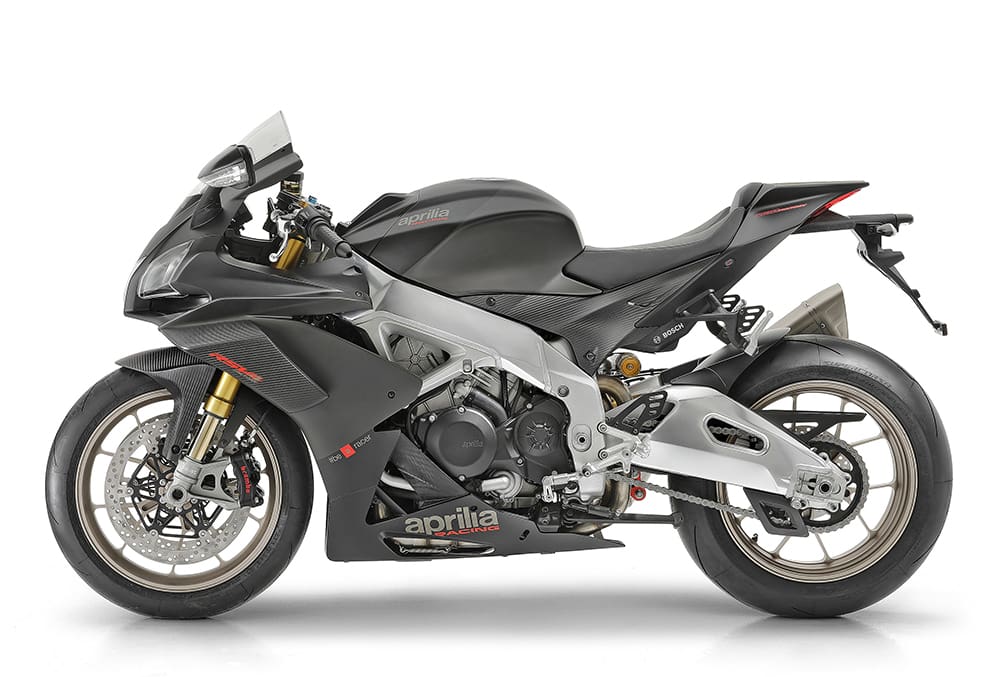
The Tuono Factory sitting next to it was equally alluring. Less power, ‘just’ 130kW (175hp) and more weight, but with the tasty addition of the Aprilia/Öhlins collaboration – Aprilia Suspension Control. Semi-active suspension on what has always been a pointy-end nakedbike? Yes, please. My first session on that weapon was surreal, for more than a few reasons.
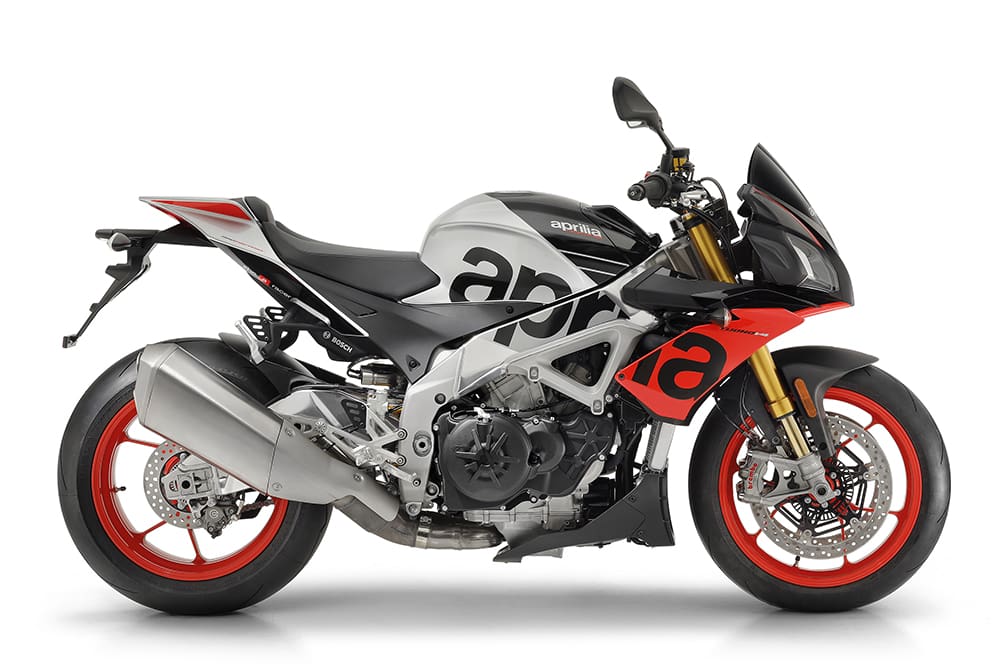
The day had dawned foggy and the track was soaked for the first session – it was always going to clear up to a sunny day, but I wasn’t there to make love to arachnids, so I left the 217hp poster child on its stands and headed out on the Tuono. The electronic suspension was set to Active Track mode on the base (read: plush) settings, but I had the traction control on four – mid range between sensitive and liberated. I didn’t want to be ‘that guy’ by sticking a new Tuono into the fence on a wet track in the first session, but the crazy thing was I would have had to make a large mistake to do so, despite the conditions.
The suspension combined with the Pirelli Supercorsa SP rubber to offer a feel to the slick SMSP surface that allowed me to feel my way around the track, straight lining it through the puddles of water highlighting many corner entries, and allowing the traction control to catch over enthusiastic throttlings.
The bike was one big comfort blanket that session – I was enjoying motoring down the steamy straight, watching the traction light buzz sporadically, skating around Turn One, then braking improbably hard into Turn Two, thanks to the electronic back up. It was like a wet road ride, only faster. And the bike was awesome. But dry track time is what we all like, and that first session on the RSV4 Factory 45mins later in dry, warm conditions was equally as memorable.
This is a bike so balanced – perfect 50/50 weight distribution helps – and so tactile, it simply cleans up your cornering lines and makes corner exits so easy to pot, it doesn’t feel like you are piloting a 215hp+ machine. It is a relatively effortless ride, thanks in part to that nimble, yet stable chassis, as well as the superb engine manners.
There is good bottom end and mid-range power, as well as that mental top-end – even with the taller fifth and sixth gears to account for the extra pulling power, I did a lap in fifth and it was easy. The slow Turn Two was challenging, but the bike did it without getting grumpy. But then again, it does everything without getting grumpy. Where the Ducati V4 S is fiery, the RSV4 Factory is calm. They are very different versions of the same thing – but there’s still plenty of soul in the RSV4.
The raspy V4, for instance, is an aural reminder you are on something special and as I launched the thing out of SMSP’s final turn for another mind-altering low pass of the main straight, clicking the perfectly-tuned race shifter as the bike’s nose hovered the first 50m, it wasn’t such a stretch to imagine myself on a World Superbike.
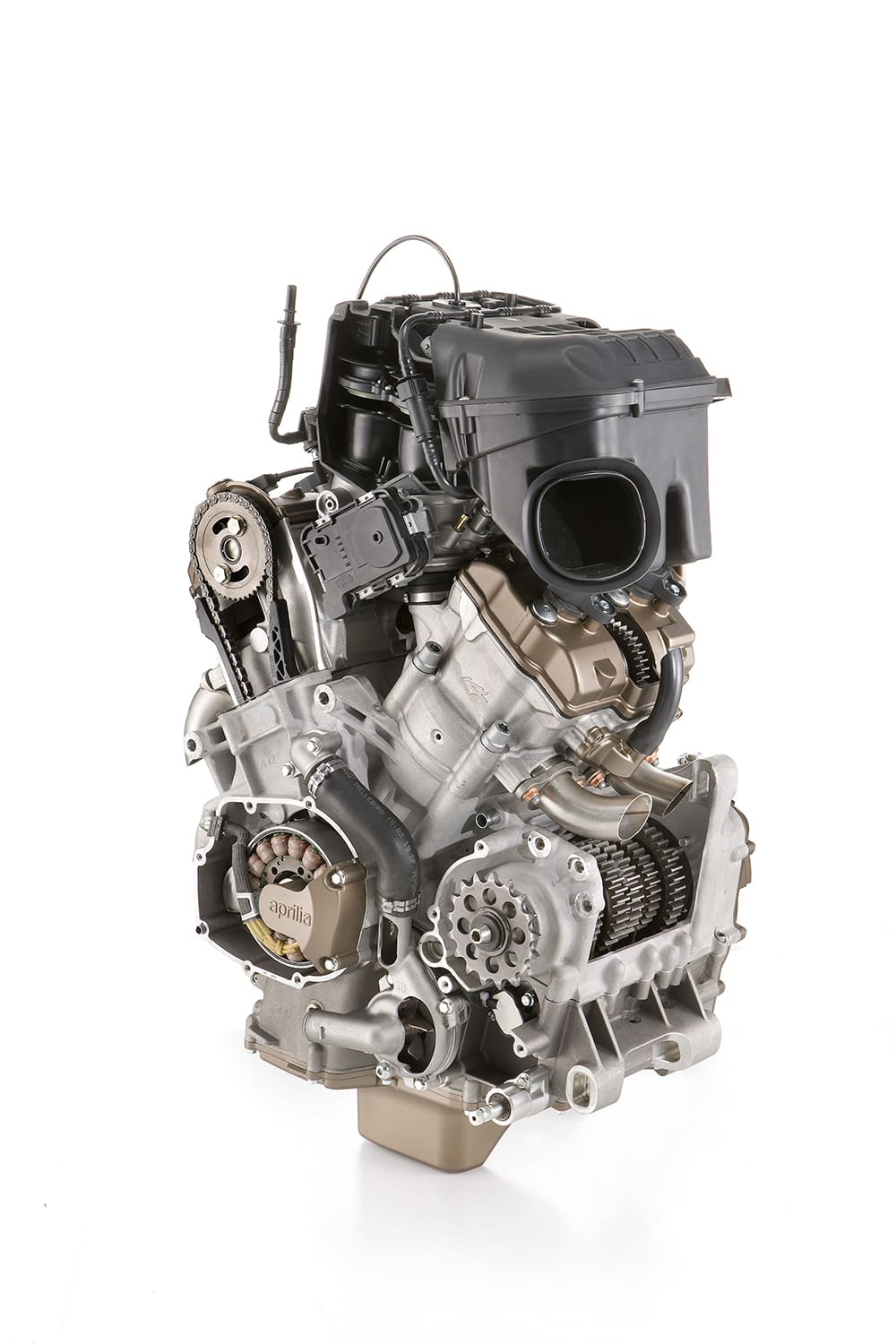
That’s exactly what I was imagining when 2003 ASBK champ and all round top bloke Craig Coxhell jumped in behind me on the camera bike. The pace lifted, of course, but that RSV4 Factory kept me tidier than I deserved, through a combination of engine manners, quality electronics, lots of grip and that ‘together’ feeling the bike has in spades. It just feels so well developed, that any mistake can be reeled in. Out-braking myself, for instance.
The Brembo Stylema calipers up front are so incredibly good, matched with insane cornering ABS, that even when I was sure I had left it too late, I simply arrived in the middle of the corner, ready to open the throttle again. The feel and power are off the charts, it was bravery, or lack of it, that prevented me going any deeper on the brakes – not the brakes themselves. The bike is worth the money for the stoppers alone and there’s few other bikes that come so equipped – the Ducati V4 S of course, and Kawasaki’s H2.
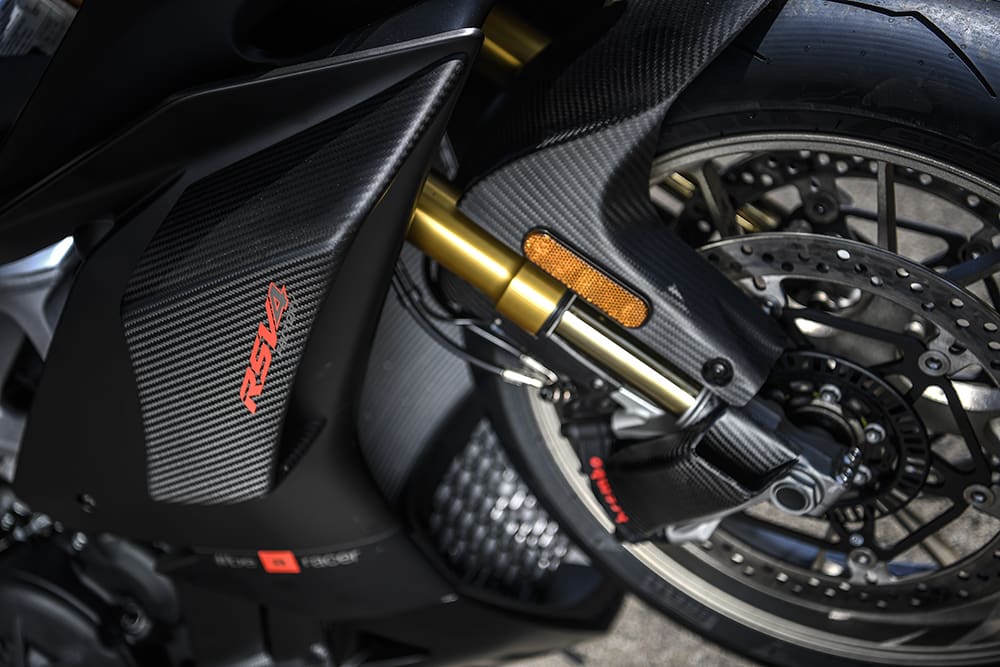
Parked next to the RSV4 Factory all day was the naked Tuono. A softer, less powerful, more comfortable version of the RSV4, it was always going to feel over powered in this company, right? Kinda, the straight was a different place to be with 40-odd less horsepower, but everywhere else, the plusher Tuono was a powerhouse.
It shares the RSV4’s overall feeling of a bike that makes the best out of every part bolted to it, sounding magnificent and feeling composed in every situation I threw at it that day at the track, but doing it with less intensity.
While the first session I spent aboard the Tuono was skatey, the second was dry and warm and grippy – and changing the bike to suit was a few button pushes away. The clever semi-active boingers (compression and rebound damping only, no electronic preload adjustment) can be set to a base setting, around which the 100-times-per-second reporting results in up to 10 damping adjustments a second, meaning in a 1m41sec lap time, the suspension set up could change up to 1000 times…
Gimmick, then? Shit no. Like all racetracks, SMSP has bumps – and those were all but ironed out as the Öhlins worked hard to not only absorb those tarmac zits, but also support the bike during heavy braking, acceleration and mid corner. I have rarely been so comfortable around a track, nor so comfortable in the feedback being delivered to me through the ’bars, ’pegs and seat.

The chassis R&D must have been ultra high level to deliver a ride quality like this and I am burning to get this bike on the road for an upcoming issue – if it works half as well as it does in the admittedly more predictable track environment, then this bike will be hard to ignore as an all round public road weapon.
The Pirelli Supercorsa SP tyres, chassis, Öhlins gear (including the steering damper) and the Aprilia Performance Ride Control System (aPRC) talk to each other so well, it feels like a step up in semi active suspension control and one that looks to accelerate as other manufacturers realise how well it can work. Based on the Öhlins Smart EC 2.0 system, it’s close to flawless. For now, Aprilia’s one of the leading lights here.
What could have let it down was access – too many manufacturers still have overly complicated means by which to operate this new tech, but on the Tuono, selecting your suspension mode – or manually adjusting damping from the bars with the ‘electronic screwdrivers’ is so simple, even technophobes should be able to manage it.
For instance, when setting your base for the semi active damping to work off, you can simply choose more or less braking support or other similarly-themed parameters – knowing what suspension terms such as compression damping actually means is no longer necessary. It was too soft initially, so I dived into the menu during a pit stop – you can’t adjust this level of parameter on the fly, but can change modes – and slowed the damping on various parameters: front firmness, rear firmness, brake support, etc. Then headed back out to a tauter feeling bike. Genius, particularly on a roadbike, as opposed to a racetrack refugee.
It is important to note that to slow damping down, you actually go minus on the settings, not plus – more than one rider went the wrong way at first. The joystick operation, menu layout and readability are all top notch, and I was thumbing my way around confidently only a few hours in. You can play with the wheelie control and traction control on the fly, with dedicated buttons for each, and these are handy as the tyres began to finally melt from some serious track time. Each bike did numerous back-to-back sessions with a variety of riders, so the cleanliness of the tyres and their longevity was impressive and only possible with good tyre warmers, the right tyre pressures and a chassis set up just right.
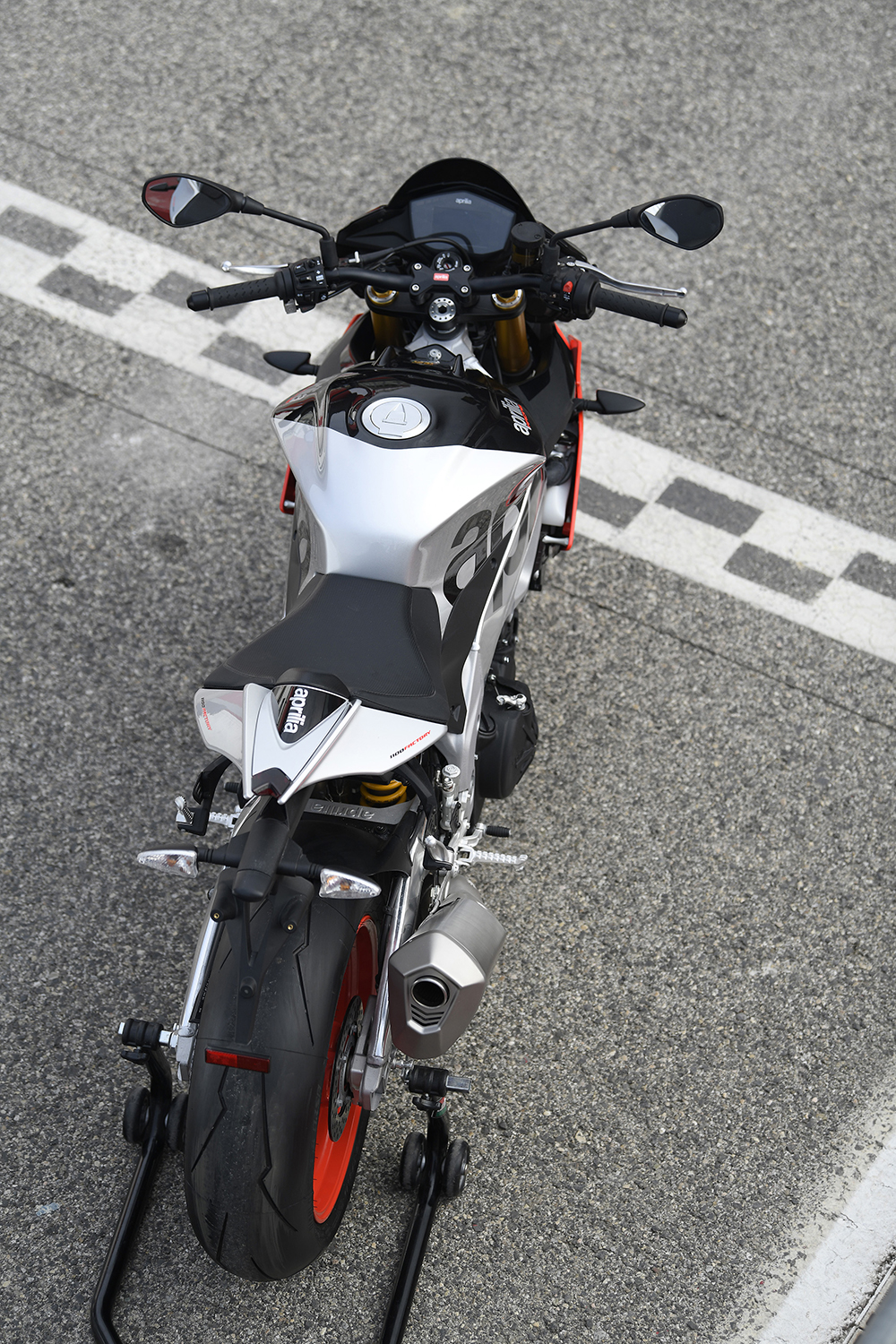
In the Factory pairing of the RSV4 and Tuono 1100s, Aprilia has two incredible machines, each at the pointy end of their respective niches. The RSV4 Factory feels so complete and so well developed to suit the new 1100 engine, as well as those superlative brakes, enhanced electronics and to know there is a sea of chassis adjustments you can make to get it just right boggles the mind. Meanwhile, the Tuono Factory’s semi active suspension just makes an excellent, class-leading bike even better, though obviously there’s a sticker price associated with it.
Can the RSV4 Factory and Tuono Factory be good value at $33,990 and $27,109 (plus on-road costs) respectively? A look around the pits said yes. The launch was held in conjunction with an Aprilia owner’s day and the pits were chockas with near-new Aprilia machinery, fresh leathers, new cars and $1100 helmets. For this demographic, riders who love new technology, well developed motorcycles and that high-end racer feel, the new Aprilias deliver. The RSV4 Factory is faster and lighter, the Tuono Factory a better ride and the pair are right up there with the best in their respective categories, as well as some of the best-sounding machines available.
The RSV4 factory is also easier to ride with more mid-range grunt, reigned in beautifully by the braking package. I reckon Aprilia’s Factory machines are worth every cent.